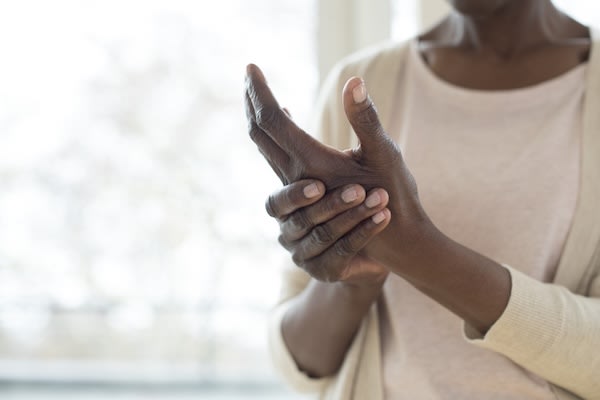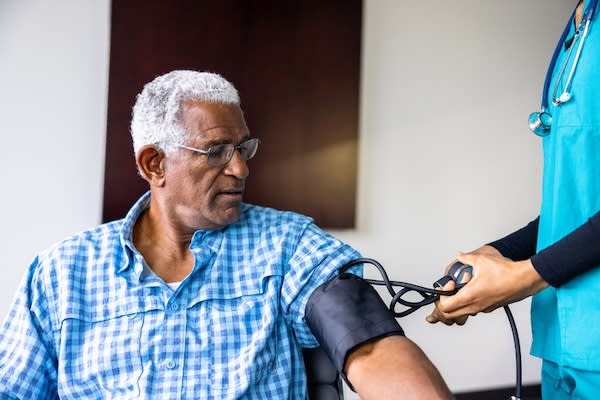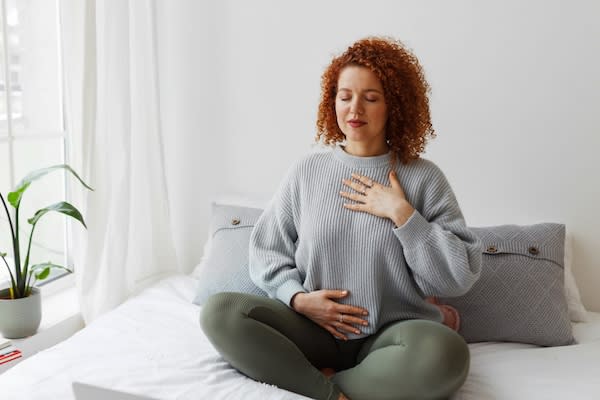What is Complex Regional Pain Syndrome?

[7 MIN READ]
In this article:
-
Complex Regional Pain Syndrome (CRPS), previously known as Reflex Sympathetic Dystrophy (RSD), is a rare condition that causes severe pain, swelling and other symptoms in your limbs, usually due to an illness or injury.
-
The most common symptom of CRPS is intense, disproportionate pain. Other signs may include difficulty moving the injured area, changes in skin color or temperature, muscle weakness or spasms, extreme sensitivity to touch or temperature, swelling and excessive sweating.
-
There are a variety of treatments for CRPS, and a combination of them can help patients manage this condition and get relief from pain. They include medications, physical and occupational therapy, psychological therapy, comprehensive rehabilitation programs, nerve blocks and spinal cord stimulation.
What is Complex Regional Pain Syndrome (CRPS)?
Complex Regional Pain Syndrome (CRPS), formerly known as Reflex Sympathetic Dystrophy (RSD) or causalgia, is a chronic condition that causes intense, disproportionate pain, swelling and other symptoms, usually in your leg, arm, hand or foot.
This rare condition has approximately 50,000 new cases per year in the United States. It affects three to four times more women than men, and people usually get it between the ages of 37 and 70.
Understanding Complex Regional Pain Syndrome
CRPS is not well understood but typically occurs after a trauma or injury. There are three types of CRPS:
- Type 1 (formerly RSD) is caused by an illness or injury to the soft tissue, such as a bruise or sprain. There’s no damage to the nerves.
- Type 2 (previously called causalgia) occurs from a nerve injury.
- Not Otherwise Specified (NOS) is CRPS that partially meets diagnostic criteria or has no obvious cause.
About 90% of all CRPS cases are Type 1. They can emerge after soft tissue or bone trauma/fracture, a skin burn, infection, surgery or stroke.
“There is a wide range of causes of CRPS,” says Steven Stanos, D.O., a pain specialist and the executive medical director of Rehabilitation and Performance Medicine at Swedish Pain Services – First Hill. “It’s primarily caused by trauma or fractures, and we occasionally see it after surgery. But in a small percentage of patients, no underlying injury or cause can be identified.”
CRPS may be triggered by an atypical and disproportionate interaction between the central nervous system (your brain and spinal cord) and the peripheral nervous system (the nerves that travel from your brain and spinal cord throughout your body).
Signs and symptoms of CRPS
CRPS symptoms may appear slowly and gradually increase over time. The most common sign is severe, constant pain occurring outside the original area of injury. Pain can be described as aching, throbbing, stinging or burning. The pain is usually more severe than expected from the injury that caused it hence the term “Regional” as part of CRPS.
Additional symptoms may include:
- Changes in hair or nail growth
- Changes in skin texture (thin, shiny, tender) in the affected limb
- Difficulty moving the injured body part
- Excessive sweating
- Extreme sensitivity to touch or temperature
- Muscle weakness, spasms or tremors
- Skin temperature or color changes (red, white, blue, mottled)
- Stiff joints
- Swelling
Some people may also have symptoms throughout their body. These may include:
- Constipation, nausea, vomiting
- Difficulty sleeping
- Fatigue
- Memory problems
- Shortness of breath
- Urinary incontinence
“The symptoms of CRPS can change over time,” Dr. Stanos says. “Some signs and symptoms can improve and resolve, while others can go on for extended periods of time lasting months or years.”
If you have constant pain in your arm or leg that gets worse if you touch it or move it, see your doctor. They may refer you to a pain specialist, neurologist or physiatrist, who typically diagnose CRPS.
Diagnosing CRPS
There’s no one test to diagnose CRPS. Your primary care doctor will review your medical history and perform a physical exam. You may have different tests to rule out other conditions.
These may include:
- Bone scan: To see if your bones are wearing away at the ends
- MRI: To look at changes in your tissues such as discs, ligaments, tendons, and joints
- Sweat test: To show if you perspire more on one side of your body
- Thermography test: To see if the temperature or blood flow in the affected area differs from other parts of your body
- X-rays: To check for mineral loss in your bones that may be related to not using the limb or other chemical changes in the body
CRPS is diagnosed based on the “Budapest Criteria” (a set of guidelines for diagnosis devised by pain experts and researchers). You must have either allodynia, where you feel pain from stimuli that typically aren’t painful, or hyperalgesia, an excessive response to painful stimuli.
You also must have at least one symptom in two or more of these categories:
- Motor or trophic: Problems with movement or changes in the skin, hair or nails
- Sensory: Excessive physical sensitivity
- Sudomotor or edema: Sweating or swelling
- Vasomotor: Body temperature or skin color changes
“CRPS is hard to diagnose because so many heterogeneous conditions can cause it,” Dr. Stanos says. “The first thing to do is look for other treatable conditions, like an untreated fracture or some other injury.”
According to James Babington, M.D., the chief of neurosciences at Swedish Edmonds Specialty Clinic, “To make the correct diagnosis, it’s essential to have a skilled physician who is familiar with the diagnosis and treatment of CRPS.”
Treatments for CRPS
The earlier CRPS is diagnosed, the better you usually respond to treatment. There are a variety of treatment options, and your doctor may recommend a combination.
Medications
Many medicines can reduce pain from CRPS, depending on your symptoms. These can include:
- Antidepressants and anticonvulsants
- Anesthetic creams
- Bone loss medicine
- Corticosteroids
- Opioids
- Pain relievers and anti-inflammatory drugs
Therapies
Various therapies also can help you feel better. These include:
- Acupuncture: To boost circulation and relieve pain
- Biofeedback: To relax your body
- Mirror therapy: To improve function and reduce pain
- Occupational or physical therapy: To increase mobility and function
- Psychological therapy: To treat depression and anxiety and teach mindfulness and relaxation
- Transcutaneous electrical nerve stimulation (TENS): To ease pain
Interventional treatments
For severe or persistent cases of RSD, doctors may use more advanced methods. These include:
- Neuromodulation: Drugs or electrical stimulation to alter nerve activity
- Nerve blocks: Local anesthetics that are injected around the affected nerves
- Spinal cord stimulation: Electrical pulses to mask pain signals before they reach the brain
“CRPS is probably the hardest pain condition to treat, and using several treatments together works best,” Dr. Stanos says. “The synergy between them helps patients.”
Managing CRPS at Providence
Providence has comprehensive pain centers with multidisciplinary teams to diagnose CRPS and treat patients holistically. This includes pain medicine doctors, physical therapists, occupational therapists, pain psychologists, relaxation therapists and others.
“Our teams are trained to work with chronic pain patients, and we take a broad lens look to address biological, psychological and social aspects,” Dr. Babington says. “We’re very thoughtful about applying the appropriate treatments, focusing on function, and the improvement in pain typically follows.”
At the Swedish First Hill Campus, Providence has a Structured Functional Restoration Program. Patients attend three days a week for four hours each day over one month. The program addresses using the affected area, how the brain regulates pain, coping mechanisms like mindfulness and more in individual and group therapy.
Although there isn’t a cure for CRPS, there is hope. “People can manage their pain, increase their function and decrease depression and anxiety,” Dr. Stanos says.
Dr. Babington adds, “With comprehensive treatment, people can improve their quality of life.”
Contributing caregivers
James Babington, M.D., is the chief of neurosciences at Swedish Edmonds Specialty Clinic in Edmonds, Washington, and the program medical director, medical spine, at Swedish Medical Group.

Steven Stanos, D.O., is the executive medical director of rehabilitation and performance medicine at Swedish Pain Services – First Hill in Seattle, Washington.
Find a doctor
If you are looking for a new provider, you can search for one who’s right for you in our provider directory.
Download the Providence app
It’s all in the app: easily stay connected with Providence and your health. With the Providence app, you can schedule appointments, have virtual visits from the comfort of your own home, get health recommendations personalized for you, access your health records and so much more. Learn more and download the app.
Related resources
Putting an End to the Pain: Nationally-Recognized Program Restores Lives
Explore Your Options for Non-Invasive Pain Relief
This information is not intended as a substitute for professional medical care. Always follow your health care professional’s instructions.



